
“Unlike many books of oral stories which fall flat on the printed page, Brother Blue: a narrative portrait is so alive, so vibrant, that at times I was sure I was hearing the voice of this remarkable storyteller/philosopher… Absolutely Delightful!
The Bloomsbury Review Shanta Nurullah
“…Lehrer’s most recent project is a quartet of books called The Portrait Series, published by Bay Press in Seattle. In each volume, a man on the “wobbly line between brilliance and madness” narrates his biography. Brother Blue is an ordained minister and professional raconteur who dresses in clothes trimmed with butterflies. Charlie, a musician, has been in and out of mental institutions for 17 years. Nicky D. is a retired dockworker in Long Island City, Queens, who delivers ‘barbed commentary on familial duty, work, war, money, religion—and the best way to chop garlic.’ Claude, the adopted son of a French ambassador, earned degrees in art and medicine and endured a spate of homelessness.
The Portrait Series represents Mr. Lehrer’s first attempt to reach a mainstream audience. His early work was published in editions of under a thousand and sold to collectors who recognized the author’s place in a long tradition of typographic outlaws. Others considered him too far ahead of his time. When he showed his first book Versations to a dealer more than a decade ago, the man admired its artful density, then advised Mr. Lehrer, “Come back when you’re dead.”
Now the times are beginning to catch up to him… While Mr. Lehrer’s early books can seem as boisterous as a video arcade—one does not read them so much as attend their performance—The Portrait Series shows more typographic restraint. It also shamelessly offers the pleasures of voyeurism all good books afford. Who knows? Mr. Lehrer may finally have met the times halfway.”
The New York Times Book Review Julie Lasky
_ _ _ _ _ _ _ _ _ _ _ _ _ _ _ _ _
From the introduction to Brother Blue: a narrative portrait of Brother Blue, a.k.a. Fr. Hugh Morgan Hill:
He breaks slave chains in an ivy league classroom and playacts the murder of Christ. In a carpeted living room, he rubs mud all over his face and tells the story of Muddy Duddy. At a wedding underneath an old beech tree, he dances in his bare feet and kisses the ground. Once a month he stands naked before a microphone, broadcasting a radio program from his apartment via satellite to Japan.
I ask Dr. Hugh Morgan Hill, a.k.a. Brother Blue, why he does it. He tells me, “Everywhere I turn, I see those eyes, those eyes. Everybody’s a runaway. It could be you.” I ask him for rough dates. He looks past me and says, “I was in Shakeapeare’s band. I shook his mighty spear for him.” His anchor, manager, and devoted wife, Ruth Hill (coordinator of oral history at Radcliffe’s Schlesinger Library), suggests he take at least one bite of his sandwich before beginning a seventy-two-hour storytelling marathon.
Brother Blue is to storytelling what John Coltrane is to jazz. Both start with a theme, then work it from the inside, choosing from a polyphony of tangents that leap over so many synapses in the brain — guttural rumblings, rapid-fire phrases, parenthetical asides, and unexpected hollers — then back down to the lyrical ground and out out out. Like Coltrane, Blue plays his instrument (which is his entire body) as though he and the whole broken world depended on it for deliverance.
Walking down Story Street in Cambridge, Massachusetts, people of all ages, sizes, and shades light up when they see this multihued contemporary griot covered in butterflies, bells, balloons, ribbons, and a banner announcing, BROTHER BLUE: STORYTELLER. Underneath the trappings of this roaming town crier and his allegorical tales of the triumphant underdog, is a man fueled by a faith in the transformative power of sacred service. With stacks of degrees to his credit from universities such as Harvard and Yale, Brother Blue, the official storyteller for the City of Boston and the United Nations Habitat Forum, is heralded as “the father of modern storytelling,” as well as a pioneering educator, radio artist, and theologian. Although Brother Blue continues to preside over congregations, lecture halls, nightclubs, and theaters, he devotes most of his unrelenting energy towards the public domain of street corners, parks, subways, prisons, hospitals, inner-city classrooms, and storytelling workshops.
The great-grandson of a slave owner and his slave, Brother Blue rose within the white-dominated spheres of the military, the ministry, and academia, and then emerged as one of the original Afro-American hipster rappers from the street. This portrait sheds light on a unique life and vision by giving voice to the stories behind the stories the storyteller tells.
_ _ _ _ _ _ _ _ _ _ _ _ _ _ _ _ _
“In the four new publications by Lehrer… the implications of a new kind of literature are at last being pursued… The Portrait Series is articulated with enormous feeling and care by an author with an ear superbly attuned to the cadences of spoken language. Lehrer, unlike so many contemporary graphic stylists, begins from a deep engagement with content he has created himself…”
Frieze Magazine Rick Poynor
“The arrival of the first set of Warren Lehrer’s Portrait Series is something of an event… echoes of Henry Miller… vivid evocations of family life and history. Absolutely defining and unmistakable.”
JAB (Journal of Artists’ Books) Paul Zelevansky
“Each book in The Portrait Series is a vibrant visual and narrative biography of an eccentric, prismatic and resilient personality… Riveting! Lehrer defies categorization.”
Gannet Newspapers Linda Kaplan Wagner
“With The Portrait Series Lehrer continues his pioneering work in ‘visual literature’ in which the look of the words on the page is as important as the words themselves.”
Philadelphia City Paper David Warner
“[Warren Lehrer’s] most recent effort is The Portrait Series, published by Bay Press, Inc. The series consists of four books, each a profile of a man, written by Mr. Lehrer, but presented as an autobiographical, first-person monologue. (Mr. Lehrer is at work on a series of portraits of women.) Each book is composed using an idiosyncratic synthesis of storytelling, poetry, typographic design, illustrations, and photographs. Influenced by Dadaism, futurism, and the writing of e.e. cummings, Gertrude Stein, and the American poet and painter Kenneth Patchen, Mr. Lehrer’s books explore the plasticity, the physicality of words and groups of words—words that dart and swoop and blare and recede and curl up and pop out and undulate and zoom across the page.
The stories are of men who are neither famous nor, by and large, successful in a conventional sense. ‘I was looking for people who straddled the wobbly line between brilliance and madness–people who have lived through unbelievable circumstances and come out the other end with a fierce passion for life,’ Mr. Lehrer says. His subjects [include] Brother Blue, an ordained minister who holds degrees from Harvard and Yale and is known as the official storyteller of Boston. “Brother Blue is to storytelling what John Coltrane is to jazz,” Mr. Lehrer wrote…
Collectively, the subjects in the Series make up a riveting group of eccentrics, people Mr. Lehrer refers to as ‘the stoop philosophers, sit-down comedians, and off-the-cuff bards who puncture the predictability of everyday life.’
Says Mr. Lehrer, ‘I took the liberties a painter or photographer might take when a subject sits for a portrait. And a turn of phrase, fragmentary memories, years of thought and conversation are crafted, shaped into short stories, diatribes, extended monologues through me.’
Brother Blue, remembering the embarrassment he felt as a young boy in church when his father got carried away and began shouting and speaking in tongues: ‘And my father’s goin’ RRRRRHHHHHHHHHH RRRRRRRRRHHHHHHHHHHHHHHH. He’s trying to hold it in but eventually he’s just vibratin’ in his seat. RRRRHHHHHHHHHH RRRRRRRRRHHHHHHHHHHHHHH. Suddenly he just lets go. HALLELUJAH! He starts crying and weepin’ and prayin’ HALLELUJAH HALLELUJAH HALLELUJAH HALLELUJAH. He’s on fire and I’m sinkin’ into my pew getting smaller’n smaller. I barely even exist, I’m so embarrassed’
Brother Blue and the other men who had been so open during the process of writing the books became ‘very nervous’ as press time approached, Mr. Lehrer says. ‘Brother Blue said that when he first went into a bookstore and saw dozens of copies, he felt like disappearing because he was so exposed,’ he says.
But their apprehensions quickly evaporated. ‘Now, after really reading the book several times and getting feedback from people, he says that I’m one of his two angels—his wife, Ruth, and me—who understood him and captured his soul. Brother Blue and Mr. Lehrer have given public readings from the books together.
Only a few pages into any of Mr. Lehrer’s four portraits, you begin to experience a strange sensation: You hear the characters in your mind. You’re drawn in. You’re in the conversation with them. You hear them talking to you. their stories echo in your mind long after the sound of them has ceased . . .”
The Chronicle of Higher Education Zoe Ingalls
Update:
Sadly, Brother Blue died in 2009, at 88 years old. He lived a very full, very rich life, and touched legions of people with his extraordinary gifts as a storyteller and person who felt deeply about all sentient beings. After the book came out, Brother Blue and Warren Lehrer did some reading events together. Warren read selections from the other three books in the Series, and Blue told stories from his life. In 1998, Shambhala Lion Editions produced an audio book of Brother Blue reading excerpts from Lehrer’s Brother Blue portrait book.
About the Audio Book:
“Contemporary folk tales, dramatically read in the first person by Brother Blue, deliver powerful sermons. This minister is the grandson of a white slave owner and a black slave woman in the South. Half of this tape tells two stories: a poor black father in dire poverty attempts suicide to benefit his family and a black lieutenant in the then-segregated U.S. Army deals with prejudice. Other lively homilies concern bettering race relations, ending with a paean to a beautiful wife. This collection is compelling as short stories. Especially recommended for those involved in black studies.”
Library Journal Gordon Blackwell
“Storytelling is big in folk art circles, where Brother Blue, a.k.a. Hugh Morgan Hill, Ph.D., is a living legend. This volume contains philosophical ruminations drawn from his personal experiences—the heroism of his father during the Depression, racism in the Army during WWII, his sister’s brush with death–all of which helped him develop his humanizing antiracist teaching technique. His gritty voice bespeaks the aching feet of the vagabond and the power of the earth’s mystical forces.”
AudioFile Y.R.
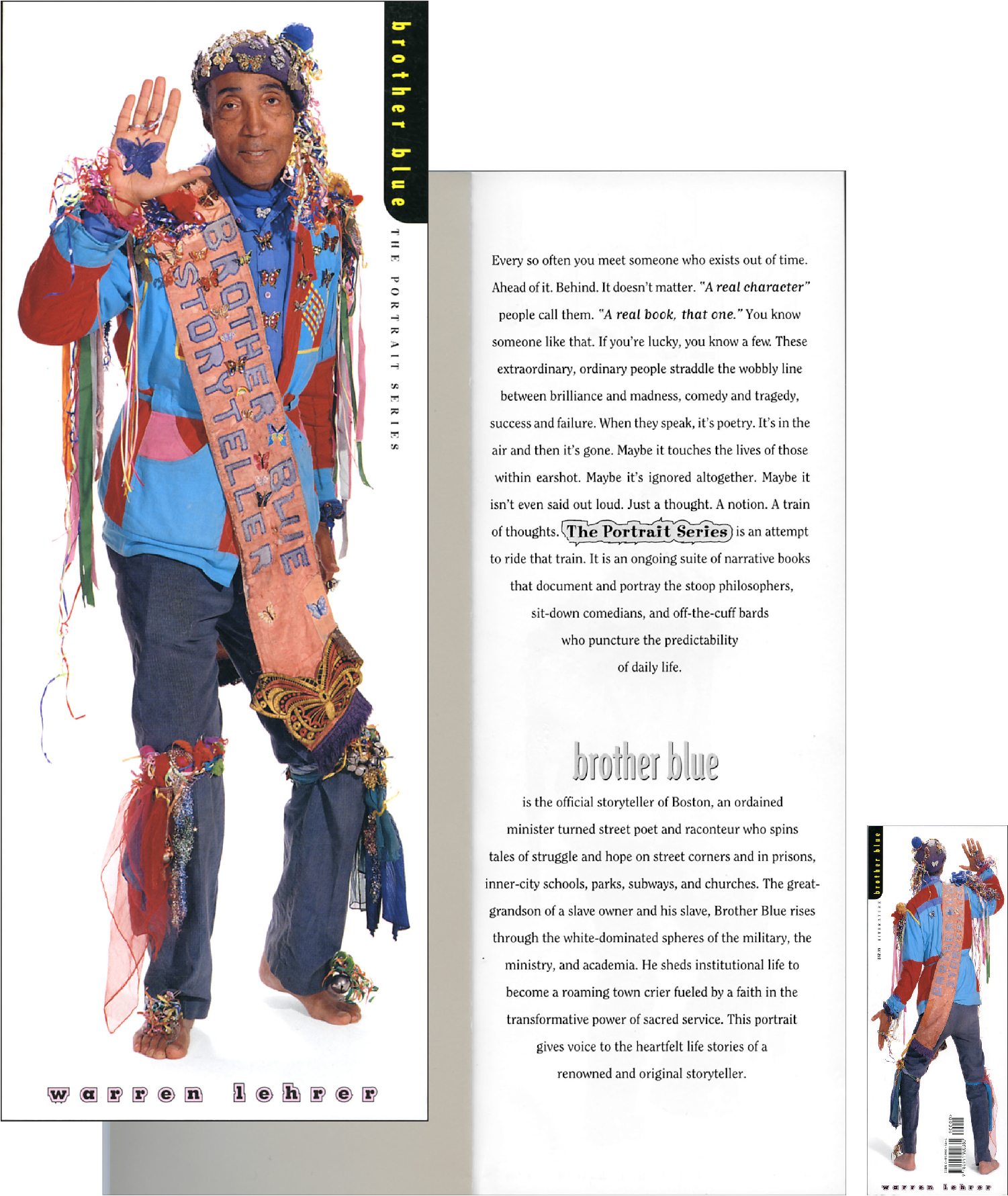
Brother Blue: A Narrative Portrait of Brother Blue, a.k.a. Dr. Hugh Morgan Hill
Written and designed by Warren Lehrer.
Published 1995 by Bay Press
6.5” x 9.75” x 267 pages. Paperback. Four color cover. One interior (black).
Part of the Portrait Series.
This expressionist portrait gives voice to the stories behind the stories of Dr. Hugh Morgan Hill, a.k.a. Brother Blue, the official storyteller of Boston and Cambridge, Massachusetts. The great grandson of a slave owner and his slave, Blue rises through the white dominated spheres of the military, the ministry and academia, then sheds institutional life to become a roaming town crier, street poet and raconteur — fueled by a transformative power of sacred service. Renowned for spinning parables of struggle and hope on street corners and in prisons, schools, subways, and churches — Brother Blue entrusted me with writing this portrait based on his seldom heard accounts of growing up during the depression under the spell of mythically heroic parents; serving as a black lieutenant during World War II in the segregated US Army; and riotous attempts at turning the hallowed traditions of the Ivy League and the church on its head!
ISBN 0-941920-36-4
BUY NOW Suggested Retail Price: $12.99 + $3 shipping and handling
BUY NOW Portrait Series: 4 book set, Special Sale: $25 + shipping and handling
[includes: Brother Blue: A Narrative Portrait of Brother Blue; Nicky D. from L.I.C.: A Narrative Portrait of Nicholas Detommaso; Claude: A Narrative Portrait of Claude Debs; Charlie: A Narrative Portrait of Charles Lang]
sample spreads
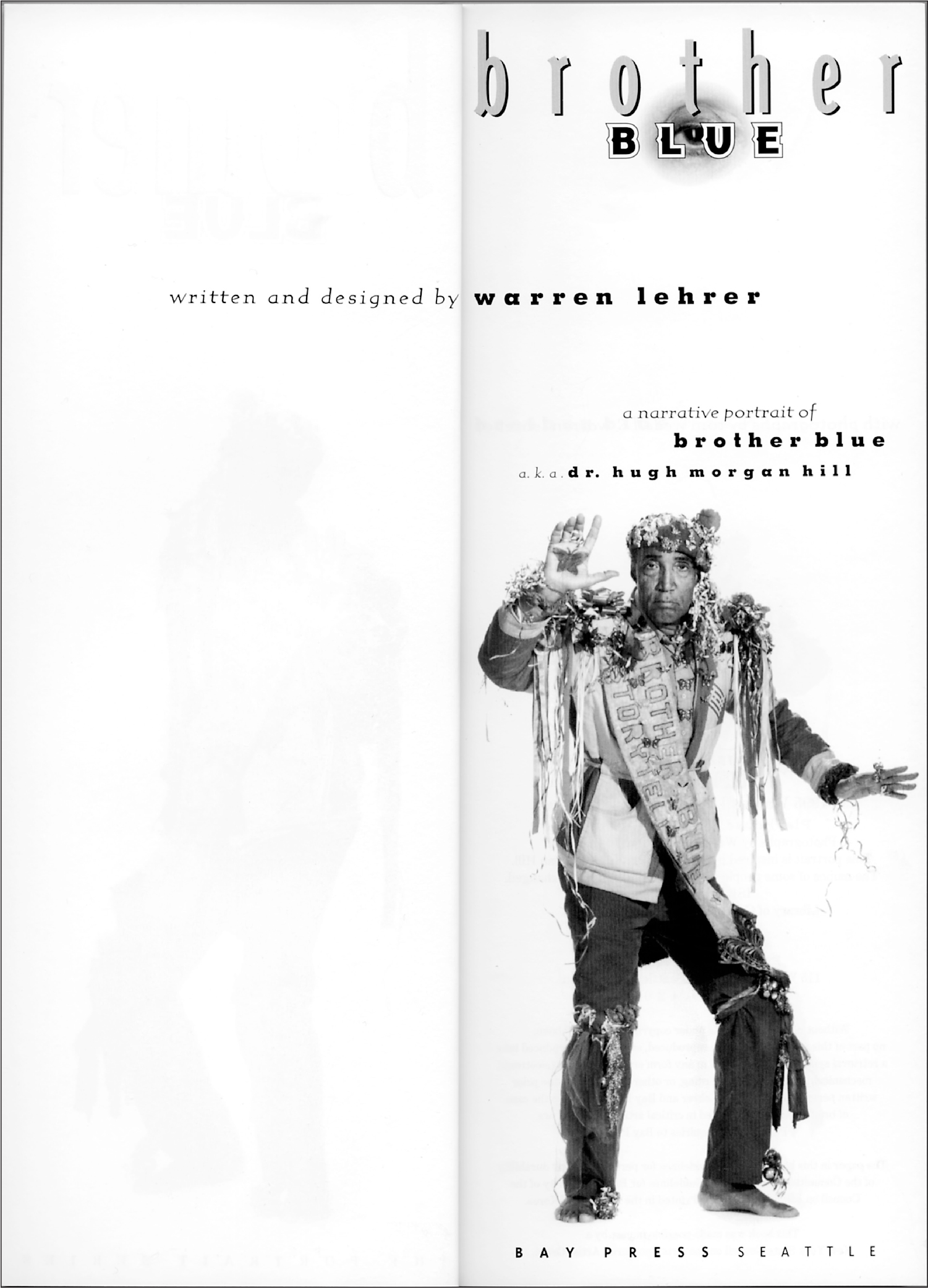
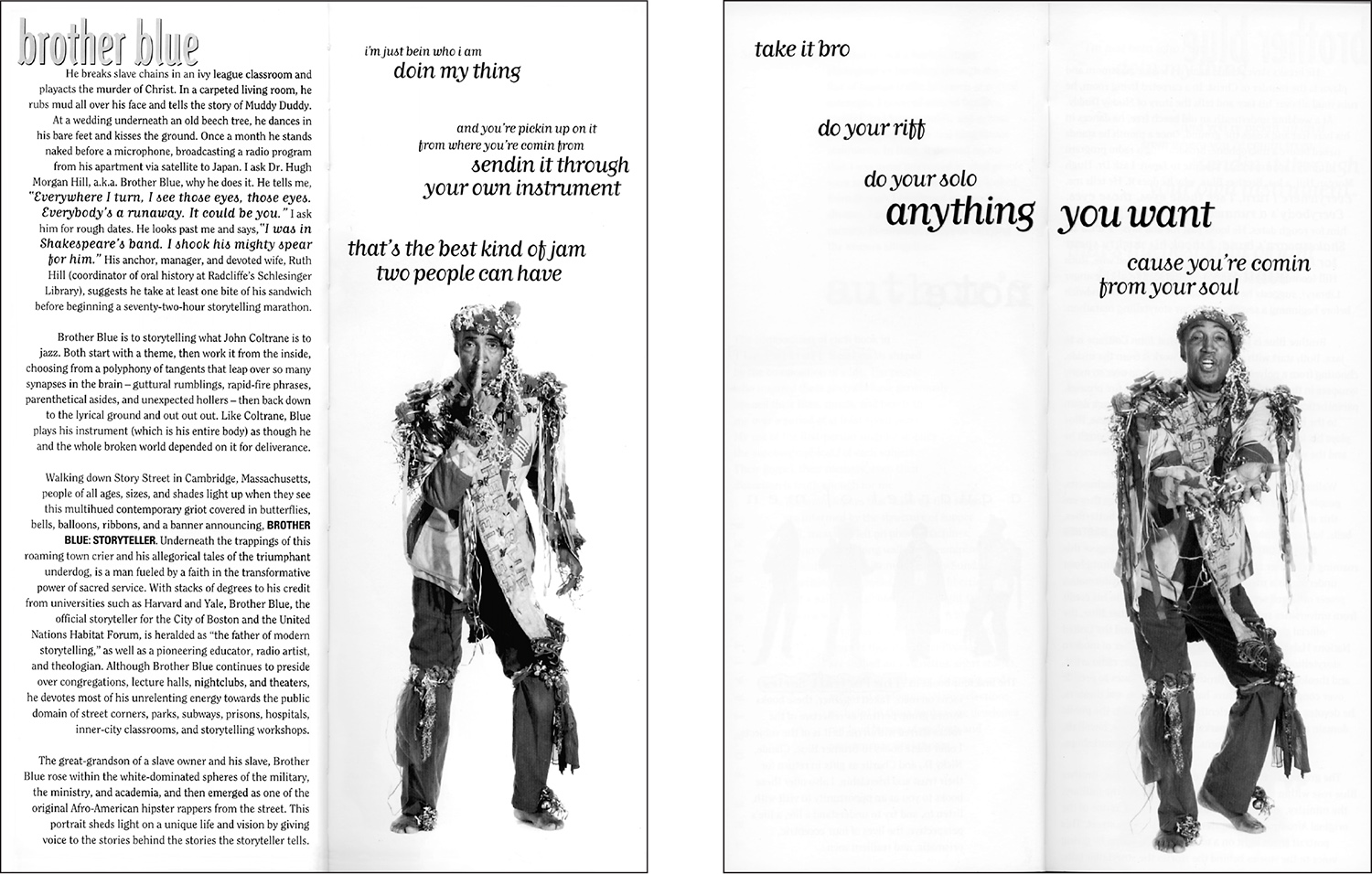

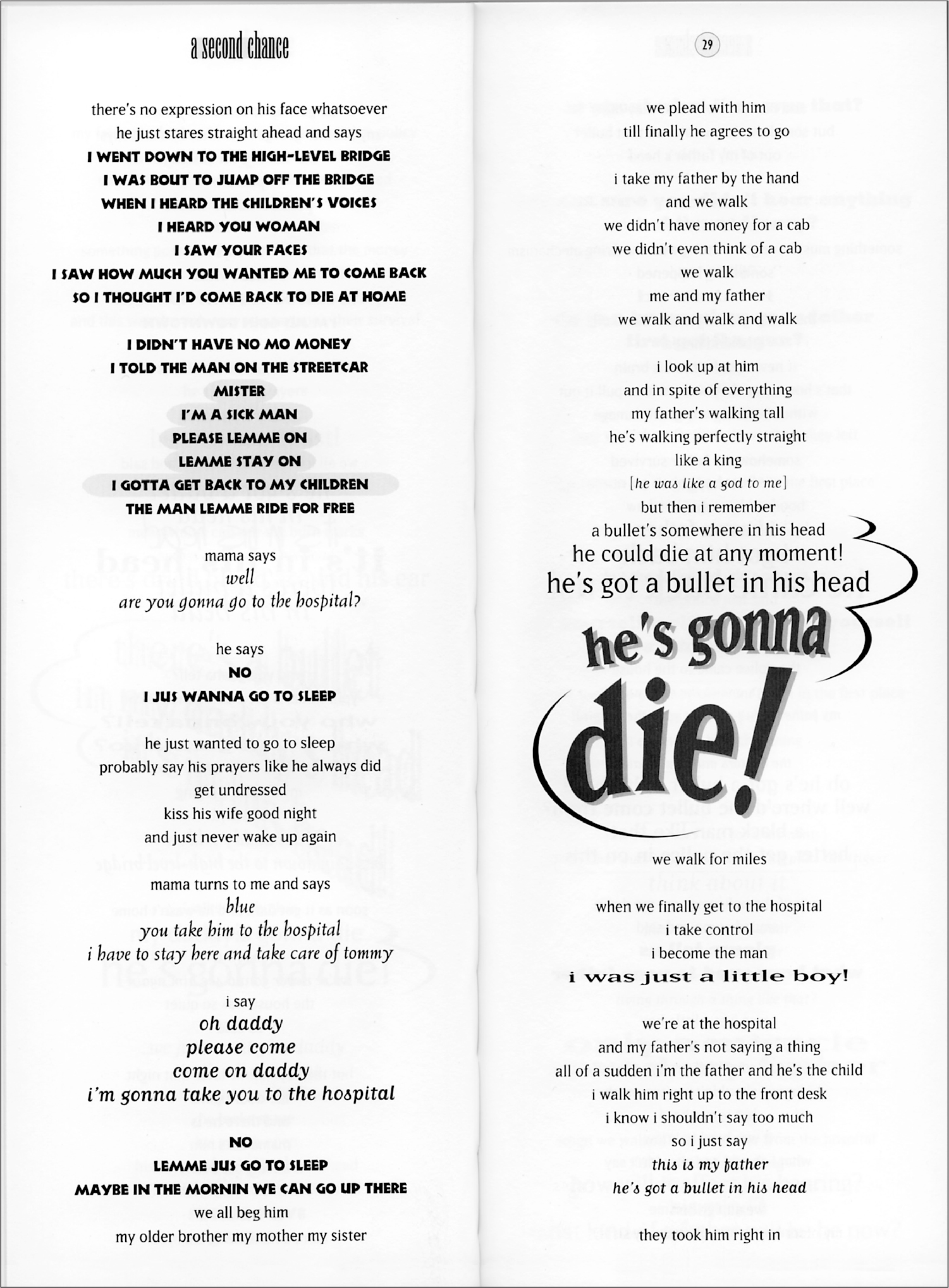

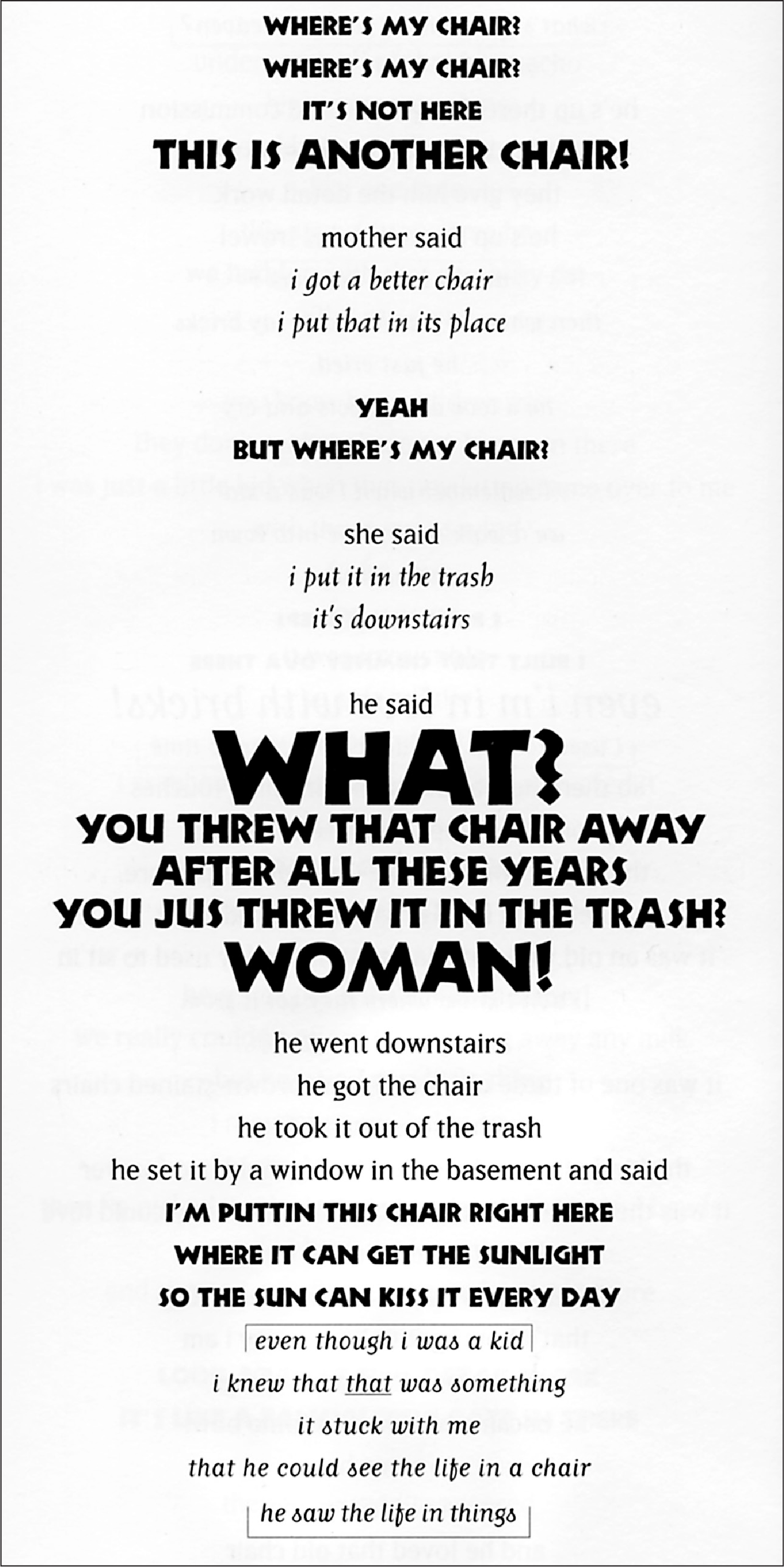
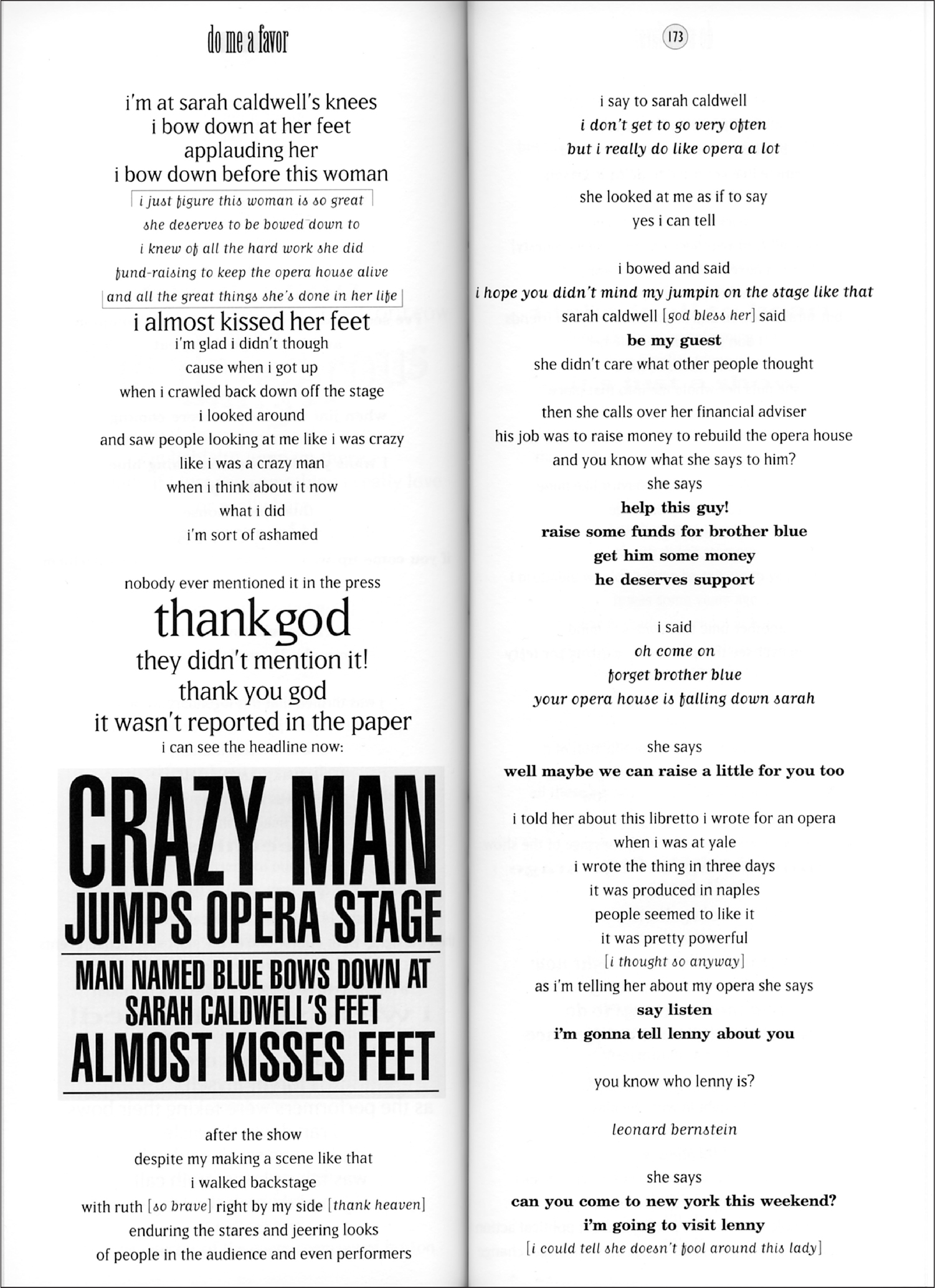
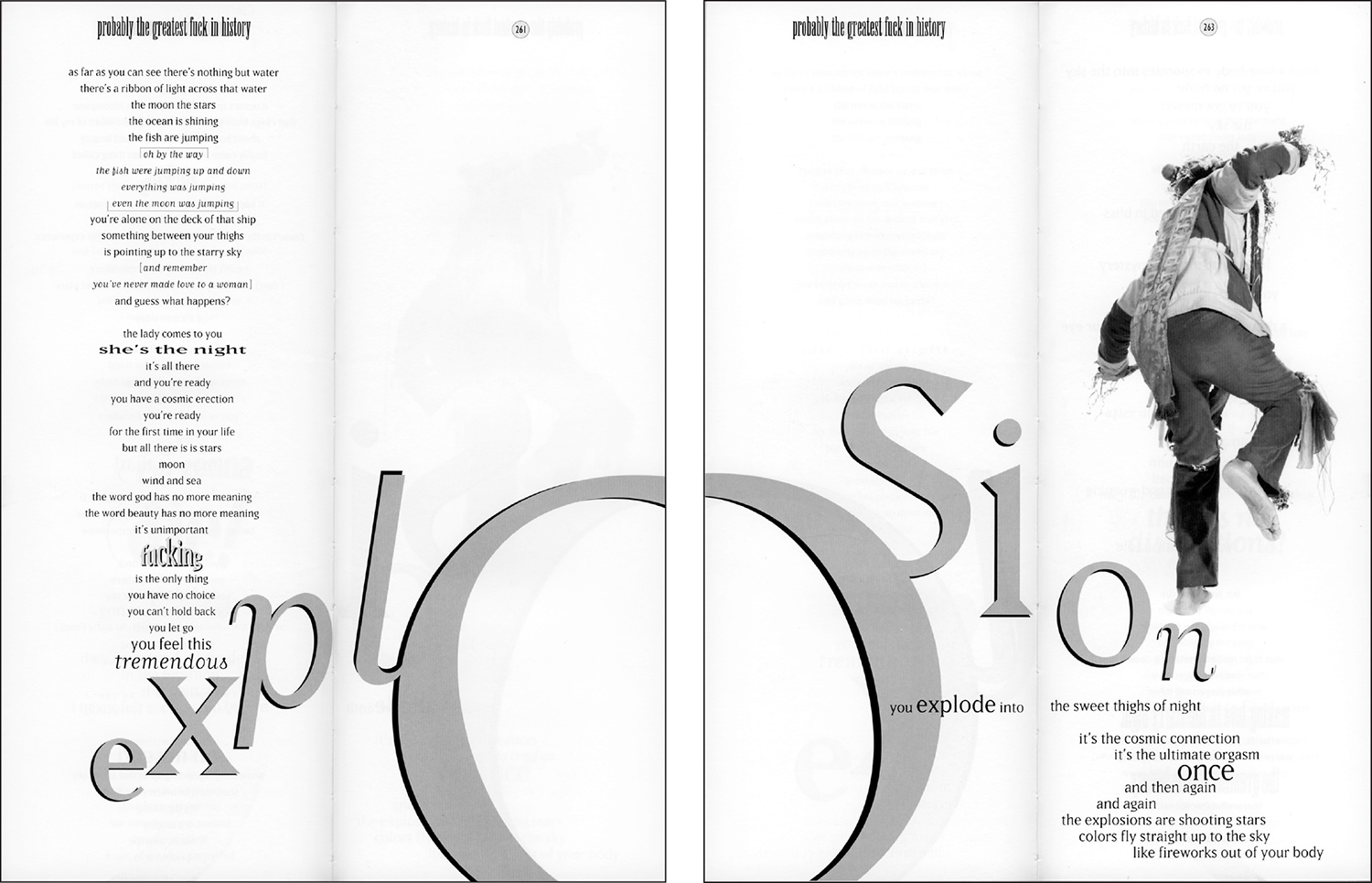
In 1998, Shambhala Lion Editions produced an audio book of Brother Blue reading excerpts from Lehrer’s Brother Blue portrait book. [Out of print. Copies can be found online.]
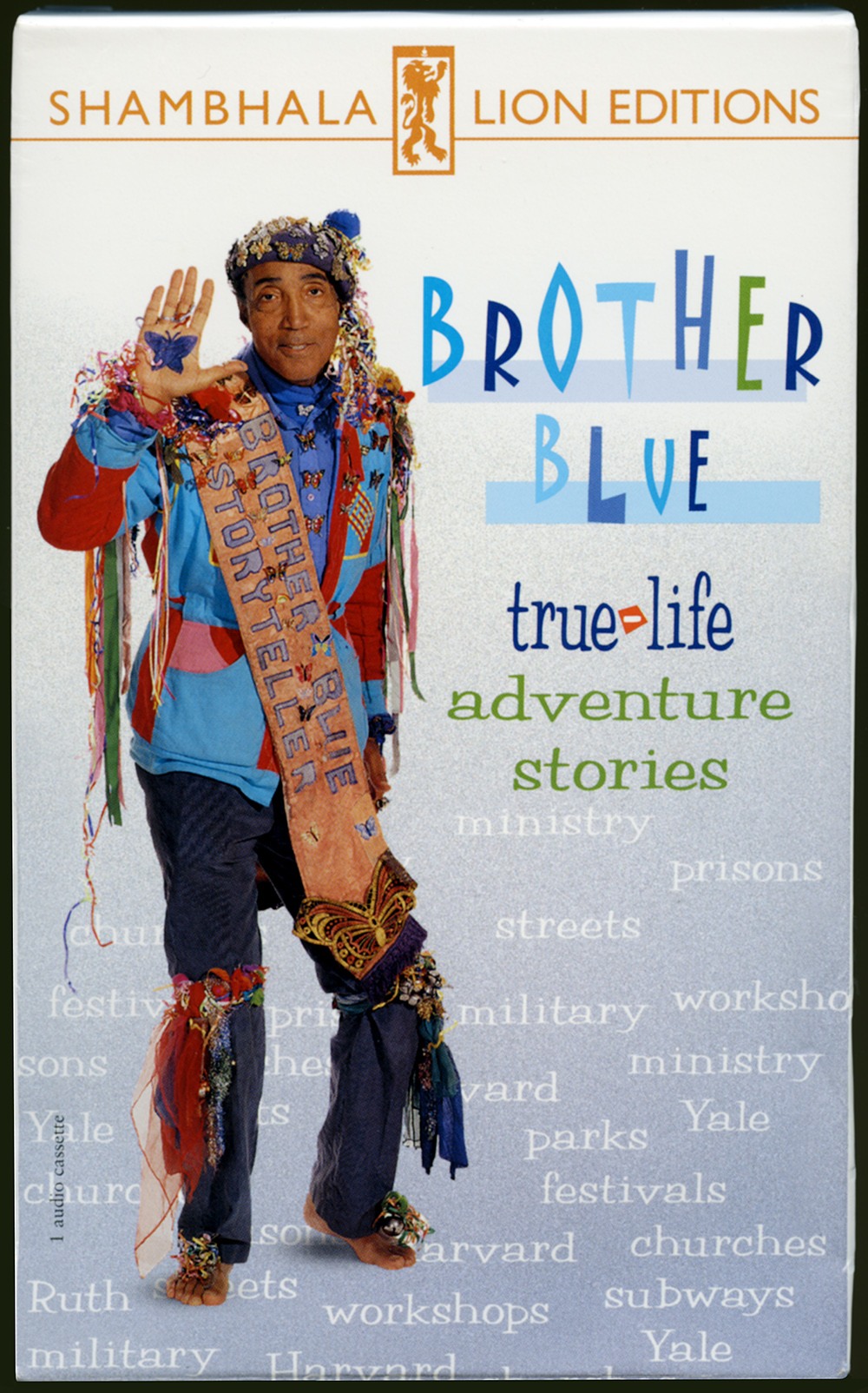
The cut “You and Me” on Harvey Goldman and Warren Lehrer’s 1991 New Music CD The Search for IT and Other Pronouns features the powerful voice of Brother Blue. The text of You and Me is culled from several pieces in the book.
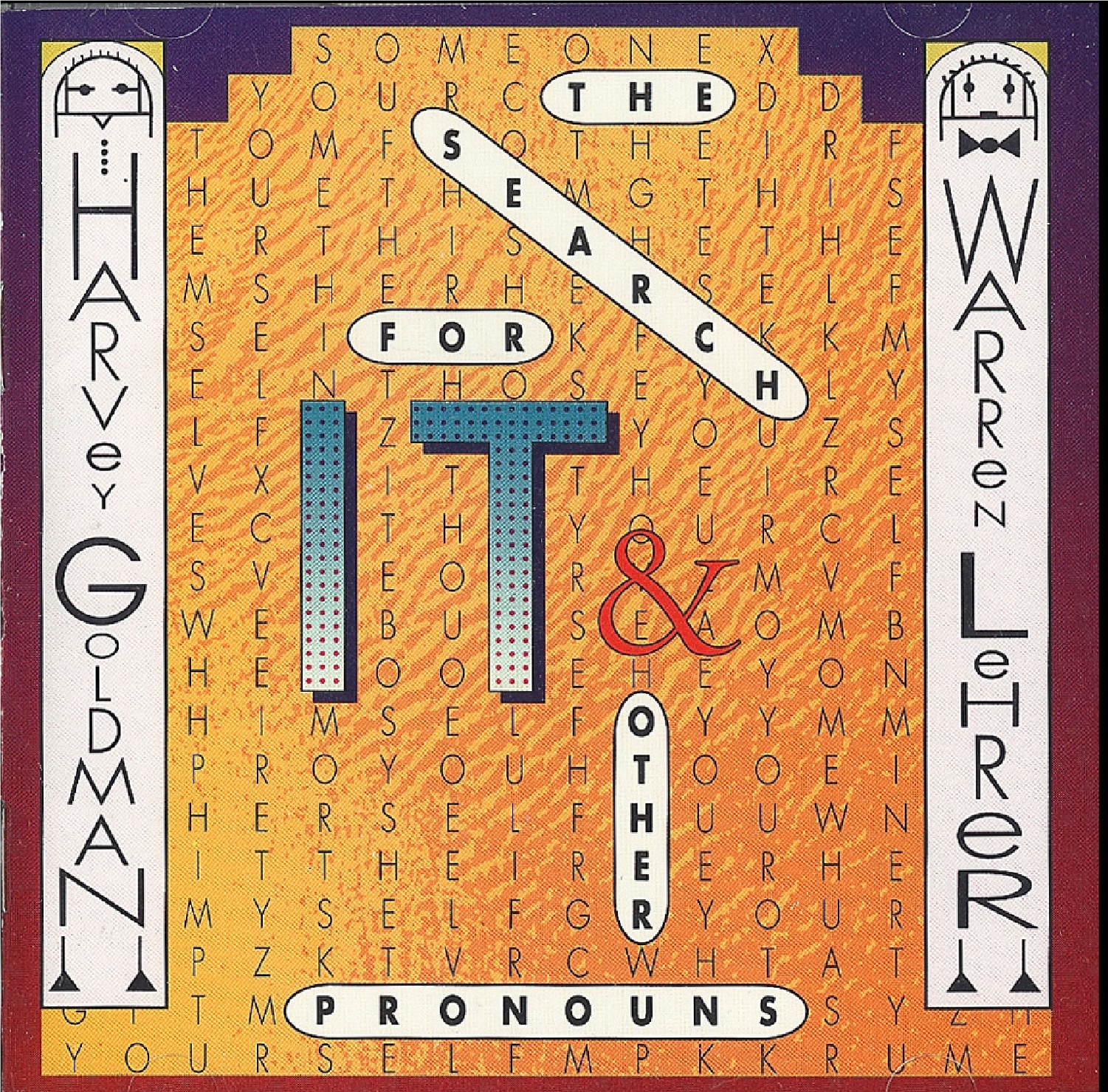
“Unlike many books of oral stories which fall flat on the printed page, Brother Blue: a narrative portrait is so alive, so vibrant, that at times I was sure I was hearing the voice of this remarkable storyteller/philosopher… Absolutely Delightful!
The Bloomsbury Review Shanta Nurullah
“…Lehrer’s most recent project is a quartet of books called The Portrait Series, published by Bay Press in Seattle. In each volume, a man on the “wobbly line between brilliance and madness” narrates his biography. Brother Blue is an ordained minister and professional raconteur who dresses in clothes trimmed with butterflies. Charlie, a musician, has been in and out of mental institutions for 17 years. Nicky D. is a retired dockworker in Long Island City, Queens, who delivers ‘barbed commentary on familial duty, work, war, money, religion—and the best way to chop garlic.’ Claude, the adopted son of a French ambassador, earned degrees in art and medicine and endured a spate of homelessness.
The Portrait Series represents Mr. Lehrer’s first attempt to reach a mainstream audience. His early work was published in editions of under a thousand and sold to collectors who recognized the author’s place in a long tradition of typographic outlaws. Others considered him too far ahead of his time. When he showed his first book Versations to a dealer more than a decade ago, the man admired its artful density, then advised Mr. Lehrer, “Come back when you’re dead.”
Now the times are beginning to catch up to him… While Mr. Lehrer’s early books can seem as boisterous as a video arcade—one does not read them so much as attend their performance—The Portrait Series shows more typographic restraint. It also shamelessly offers the pleasures of voyeurism all good books afford. Who knows? Mr. Lehrer may finally have met the times halfway.”
The New York Times Book Review Julie Lasky
_ _ _ _ _ _ _ _ _ _ _ _ _ _ _ _ _
From the introduction to Brother Blue: a narrative portrait of Brother Blue, a.k.a. Fr. Hugh Morgan Hill:
He breaks slave chains in an ivy league classroom and playacts the murder of Christ. In a carpeted living room, he rubs mud all over his face and tells the story of Muddy Duddy. At a wedding underneath an old beech tree, he dances in his bare feet and kisses the ground. Once a month he stands naked before a microphone, broadcasting a radio program from his apartment via satellite to Japan.
I ask Dr. Hugh Morgan Hill, a.k.a. Brother Blue, why he does it. He tells me, “Everywhere I turn, I see those eyes, those eyes. Everybody’s a runaway. It could be you.” I ask him for rough dates. He looks past me and says, “I was in Shakeapeare’s band. I shook his mighty spear for him.” His anchor, manager, and devoted wife, Ruth Hill (coordinator of oral history at Radcliffe’s Schlesinger Library), suggests he take at least one bite of his sandwich before beginning a seventy-two-hour storytelling marathon.
Brother Blue is to storytelling what John Coltrane is to jazz. Both start with a theme, then work it from the inside, choosing from a polyphony of tangents that leap over so many synapses in the brain — guttural rumblings, rapid-fire phrases, parenthetical asides, and unexpected hollers — then back down to the lyrical ground and out out out. Like Coltrane, Blue plays his instrument (which is his entire body) as though he and the whole broken world depended on it for deliverance.
Walking down Story Street in Cambridge, Massachusetts, people of all ages, sizes, and shades light up when they see this multihued contemporary griot covered in butterflies, bells, balloons, ribbons, and a banner announcing, BROTHER BLUE: STORYTELLER. Underneath the trappings of this roaming town crier and his allegorical tales of the triumphant underdog, is a man fueled by a faith in the transformative power of sacred service. With stacks of degrees to his credit from universities such as Harvard and Yale, Brother Blue, the official storyteller for the City of Boston and the United Nations Habitat Forum, is heralded as “the father of modern storytelling,” as well as a pioneering educator, radio artist, and theologian. Although Brother Blue continues to preside over congregations, lecture halls, nightclubs, and theaters, he devotes most of his unrelenting energy towards the public domain of street corners, parks, subways, prisons, hospitals, inner-city classrooms, and storytelling workshops.
The great-grandson of a slave owner and his slave, Brother Blue rose within the white-dominated spheres of the military, the ministry, and academia, and then emerged as one of the original Afro-American hipster rappers from the street. This portrait sheds light on a unique life and vision by giving voice to the stories behind the stories the storyteller tells.
_ _ _ _ _ _ _ _ _ _ _ _ _ _ _ _ _
“In the four new publications by Lehrer… the implications of a new kind of literature are at last being pursued… The Portrait Series is articulated with enormous feeling and care by an author with an ear superbly attuned to the cadences of spoken language. Lehrer, unlike so many contemporary graphic stylists, begins from a deep engagement with content he has created himself…”
Frieze Magazine Rick Poynor
“The arrival of the first set of Warren Lehrer’s Portrait Series is something of an event… echoes of Henry Miller… vivid evocations of family life and history. Absolutely defining and unmistakable.”
JAB (Journal of Artists’ Books) Paul Zelevansky
“Each book in The Portrait Series is a vibrant visual and narrative biography of an eccentric, prismatic and resilient personality… Riveting! Lehrer defies categorization.”
Gannet Newspapers Linda Kaplan Wagner
“With The Portrait Series Lehrer continues his pioneering work in ‘visual literature’ in which the look of the words on the page is as important as the words themselves.”
Philadelphia City Paper David Warner
“[Warren Lehrer’s] most recent effort is The Portrait Series, published by Bay Press, Inc. The series consists of four books, each a profile of a man, written by Mr. Lehrer, but presented as an autobiographical, first-person monologue. (Mr. Lehrer is at work on a series of portraits of women.) Each book is composed using an idiosyncratic synthesis of storytelling, poetry, typographic design, illustrations, and photographs. Influenced by Dadaism, futurism, and the writing of e.e. cummings, Gertrude Stein, and the American poet and painter Kenneth Patchen, Mr. Lehrer’s books explore the plasticity, the physicality of words and groups of words—words that dart and swoop and blare and recede and curl up and pop out and undulate and zoom across the page.
The stories are of men who are neither famous nor, by and large, successful in a conventional sense. ‘I was looking for people who straddled the wobbly line between brilliance and madness–people who have lived through unbelievable circumstances and come out the other end with a fierce passion for life,’ Mr. Lehrer says. His subjects [include] Brother Blue, an ordained minister who holds degrees from Harvard and Yale and is known as the official storyteller of Boston. “Brother Blue is to storytelling what John Coltrane is to jazz,” Mr. Lehrer wrote…
Collectively, the subjects in the Series make up a riveting group of eccentrics, people Mr. Lehrer refers to as ‘the stoop philosophers, sit-down comedians, and off-the-cuff bards who puncture the predictability of everyday life.’
Says Mr. Lehrer, ‘I took the liberties a painter or photographer might take when a subject sits for a portrait. And a turn of phrase, fragmentary memories, years of thought and conversation are crafted, shaped into short stories, diatribes, extended monologues through me.’
Brother Blue, remembering the embarrassment he felt as a young boy in church when his father got carried away and began shouting and speaking in tongues: ‘And my father’s goin’ RRRRRHHHHHHHHHH RRRRRRRRRHHHHHHHHHHHHHHH. He’s trying to hold it in but eventually he’s just vibratin’ in his seat. RRRRHHHHHHHHHH RRRRRRRRRHHHHHHHHHHHHHH. Suddenly he just lets go. HALLELUJAH! He starts crying and weepin’ and prayin’ HALLELUJAH HALLELUJAH HALLELUJAH HALLELUJAH. He’s on fire and I’m sinkin’ into my pew getting smaller’n smaller. I barely even exist, I’m so embarrassed’
Brother Blue and the other men who had been so open during the process of writing the books became ‘very nervous’ as press time approached, Mr. Lehrer says. ‘Brother Blue said that when he first went into a bookstore and saw dozens of copies, he felt like disappearing because he was so exposed,’ he says.
But their apprehensions quickly evaporated. ‘Now, after really reading the book several times and getting feedback from people, he says that I’m one of his two angels—his wife, Ruth, and me—who understood him and captured his soul. Brother Blue and Mr. Lehrer have given public readings from the books together.
Only a few pages into any of Mr. Lehrer’s four portraits, you begin to experience a strange sensation: You hear the characters in your mind. You’re drawn in. You’re in the conversation with them. You hear them talking to you. their stories echo in your mind long after the sound of them has ceased . . .”
The Chronicle of Higher Education Zoe Ingalls
Update:
Sadly, Brother Blue died in 2009, at 88 years old. He lived a very full, very rich life, and touched legions of people with his extraordinary gifts as a storyteller and person who felt deeply about all sentient beings. After the book came out, Brother Blue and Warren Lehrer did some reading events together. Warren read selections from the other three books in the Series, and Blue told stories from his life. In 1998, Shambhala Lion Editions produced an audio book of Brother Blue reading excerpts from Lehrer’s Brother Blue portrait book.
About the Audio Book:
“Contemporary folk tales, dramatically read in the first person by Brother Blue, deliver powerful sermons. This minister is the grandson of a white slave owner and a black slave woman in the South. Half of this tape tells two stories: a poor black father in dire poverty attempts suicide to benefit his family and a black lieutenant in the then-segregated U.S. Army deals with prejudice. Other lively homilies concern bettering race relations, ending with a paean to a beautiful wife. This collection is compelling as short stories. Especially recommended for those involved in black studies.”
Library Journal Gordon Blackwell
“Storytelling is big in folk art circles, where Brother Blue, a.k.a. Hugh Morgan Hill, Ph.D., is a living legend. This volume contains philosophical ruminations drawn from his personal experiences—the heroism of his father during the Depression, racism in the Army during WWII, his sister’s brush with death–all of which helped him develop his humanizing antiracist teaching technique. His gritty voice bespeaks the aching feet of the vagabond and the power of the earth’s mystical forces.”
AudioFile Y.R.
